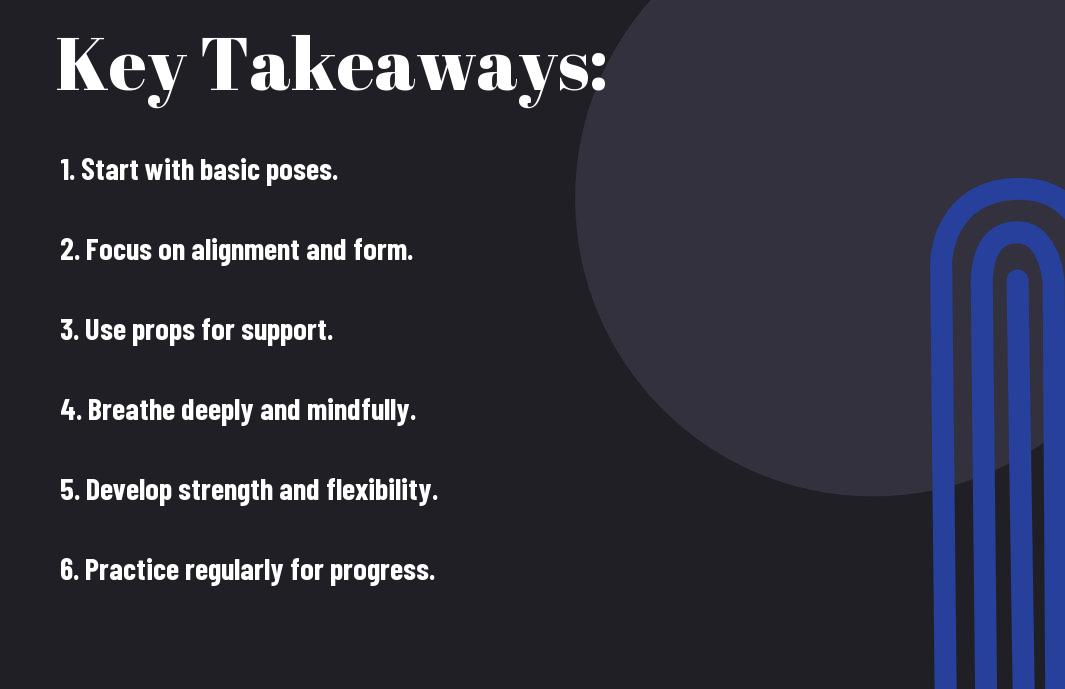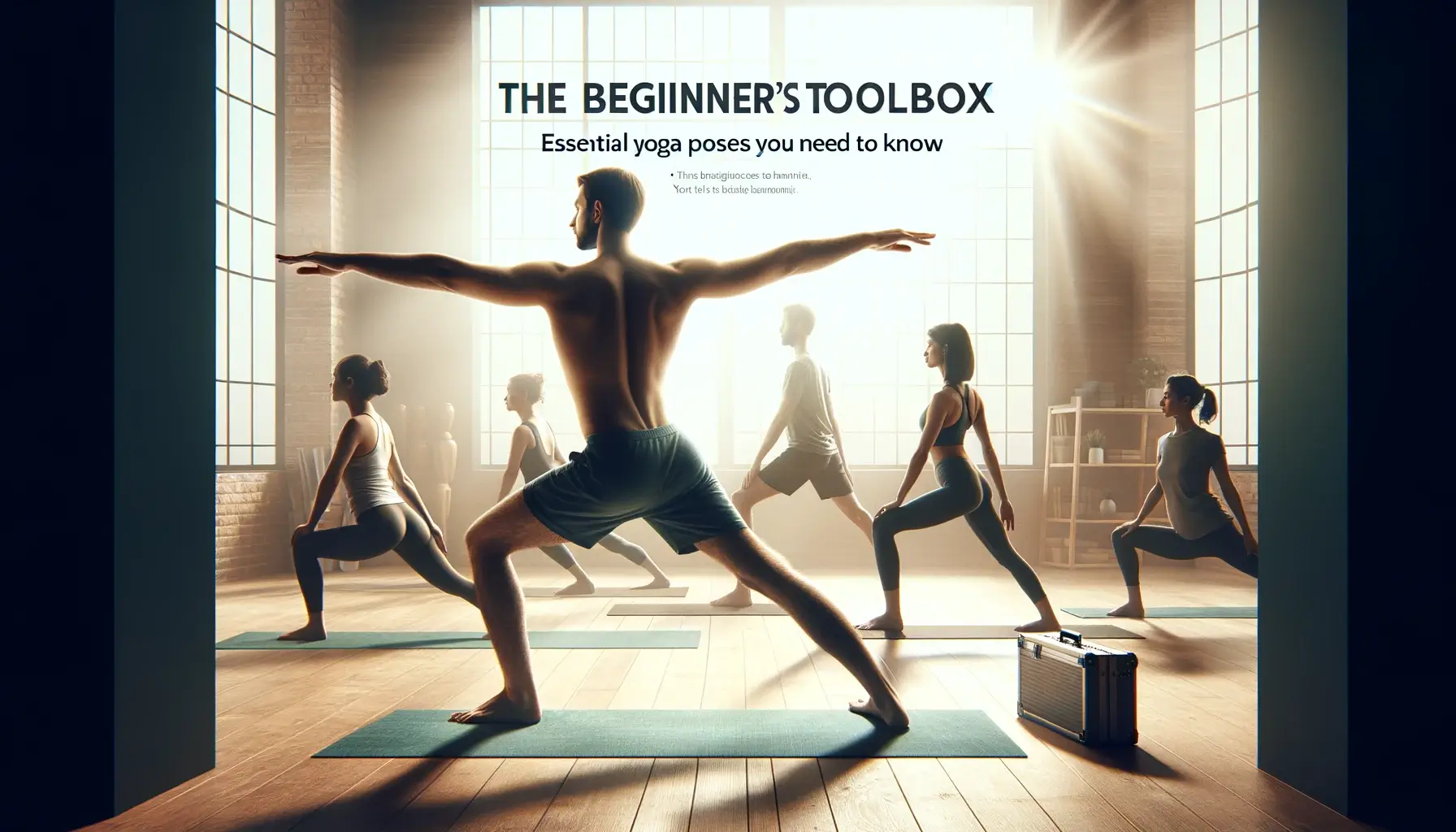Yoga beginners often find themselves overwhelmed with the myriad of poses out there, unsure of where to start. In this comprehensive guide, we will break down the crucial yoga poses you need to know to kickstart your practice with confidence. Whether you’re looking to improve flexibility, build strength, or find inner peace, mastering these foundational poses will set you on the path to a fulfilling yoga journey. From Downward Dog to Tree Pose, we’ve got you covered with step-by-step instructions and alignment tips to help you perfect each posture. Let’s roll out our mats and examine into the beginner’s toolbox of crucial yoga poses.
Key Takeaways:
- Variety of Poses: Learning a variety of important yoga poses helps in building a strong foundation for your practice.
- Focus on Alignment: Paying attention to proper alignment in each pose can prevent injuries and maximize the benefits of the practice.
- Breath Awareness: Connecting breath with movement in each pose enhances your practice, promotes relaxation, and improves mindfulness.

The Foundation of Yoga
If you’re new to the world of yoga, understanding the basics is important before you look into your practice. The foundation of yoga lies in the postures, also known as asanas, which form the core of any yoga routine. These postures not only help in improving flexibility and strength but also play a crucial role in balancing the body and mind.
Understanding Yoga Postures
The key to mastering yoga postures lies in understanding their purpose and benefits. Each posture is designed to target specific parts of the body, such as the back, legs, arms, or core, helping to stretch and strengthen those areas. By practicing a variety of poses, you can work towards achieving a well-rounded practice that benefits both your physical and mental well-being.
The alignment of your body in each posture is vital for reaping the full benefits of the pose. Proper alignment not only prevents injuries but also ensures that you are engaging the right muscles and gaining maximum effectiveness from the pose. Keep in mind, yoga is not just about getting into a pose but doing it mindfully and with correct alignment.
Breathing and Alignment Basics
The breath is the foundation of any yoga practice. Breath control, also known as pranayama, helps to synchronize movement with breath, creating a sense of flow in your practice. Proper breathing techniques can aid in relaxation, focus, and cultivating awareness. Alignment, on the other hand, involves the correct positioning of your body in each posture. It ensures that you are not only safe from injury but also reaping the intended benefits of the pose.
Basics of breathing and alignment are often taught at the beginning of a yoga class to lay the groundwork for a safe and effective practice. Learning how to breathe deeply and engage the correct muscles will not only enhance your practice but also deepen your mind-body connection. By focusing on these fundamentals, you can set a solid foundation for your yoga journey.

Essential Yoga Poses for Beginners
Standing Poses
For beginners, standing poses are a great way to build strength, improve balance, and increase flexibility. Any beginner can start with poses like Mountain Pose (Tadasana), Warrior I (Virabhadrasana I), and Tree Pose (Vrksasana). These poses help in grounding, finding stability, and creating a strong foundation for the practice.
Standing poses also help beginners to focus on their breath and cultivate mindfulness while holding the poses. As you progress in your practice, you can explore more challenging standing poses like Warrior II (Virabhadrasana II), Triangle Pose (Trikonasana), and Extended Side Angle Pose (Utthita Parsvakonasana).
Seated Poses
Standing poses are complemented by seated poses that offer an opportunity to work on hip opening, spinal alignment, and overall flexibility. Seated poses like Seated Forward Bend (Paschimottanasana), Easy Pose (Sukhasana), and Bound Angle Pose (Baddha Konasana) are ideal for beginners to stretch the lower back, hips, and groin areas.
Seated poses are also beneficial for calming the mind and preparing the body for relaxation or meditation. Practicing seated poses regularly can help beginners improve their posture, increase mobility in the hips, and relieve tension in the back and shoulders.
Forward Bends
Forward bending poses are excellent for stretching the hamstrings, lengthening the spine, and promoting relaxation. Beginners can start with poses like Standing Forward Bend (Uttanasana), Seated Forward Bend (Paschimottanasana), and Child’s Pose (Balasana) to release tension in the back and hamstrings.
Staff Pose (Dandasana) is a foundational pose for forward bends as it helps in strengthening the core, improving posture, and preparing the body for deeper forward bends. Practicing forward bends regularly can also help beginners to calm the mind, reduce stress, and improve digestion.
Strength and Balance Yoga Poses
Arm Strength Poses
Balance is crucial in yoga practice, and arm strength plays a significant role in maintaining stability during various poses. Poses like Plank, Chaturanga, and Side Plank are excellent for building arm strength. These poses not only strengthen the arms but also engage the core muscles for added stability. Practicing these poses regularly will help you improve your overall strength and balance.
Another beneficial arm strength pose is Dolphin Pose, which strengthens the arms, shoulders, and upper back. This pose also helps improve flexibility in the shoulders and hamstrings. As you progress in your practice, you can explore more challenging arm balances like Crow Pose and Firefly Pose to further enhance your arm strength and balance.
Balance Postures
Balance postures in yoga require focus, strength, and coordination. Poses like Tree Pose, Eagle Pose, and Warrior III are great for improving balance and stability. These poses not only work on physical balance but also help calm the mind and improve concentration. Incorporating balance postures into your practice can help you develop a strong mind-body connection and enhance your overall sense of well-being.
The practice of balance postures in yoga is not just about physical stability; it also promotes mental clarity and emotional balance. These poses challenge you to stay present in the moment and find your center amidst distractions. Embrace the wobbling and falling as part of the learning process, and over time, you will notice an improvement in your balance, both on and off the mat.
Staff
Staff Pose, or Dandasana, is a foundational seated posture that helps improve posture, strengthen the core, and elongate the spine. In this pose, you sit with your legs extended in front of you, spine tall, and palms pressing into the mat beside your hips. Staff Pose is an excellent way to engage the muscles of the legs, abdomen, and back while promoting proper alignment and stability. It serves as a preparation for more advanced seated poses and inversions, making it an imperative part of any yoga practice.
Relaxation and Restorative Poses
After a long day or a strenuous yoga practice, it’s important to give your body the relaxation and rest it deserves. Incorporating relaxation and restorative poses into your routine can help release tension, calm the mind, and promote overall well-being. These poses focus on gentle stretches and deep breathing, allowing you to unwind and rejuvenate.
Gentle Backbends
Gentle backbends are a great way to open up the chest and shoulders while also gently stretching the spine. Poses like Sphinx Pose or Baby Cobra are perfect for beginners or those looking for a soothing backbend. By lifting the chest and arching the back slightly, you can release tension in the front of the body and counteract the effects of slouching or sitting for long periods.
Practicing gentle backbends can also help improve posture and increase flexibility in the spine. Remember to listen to your body and only go as far as feels comfortable. Focus on breathing deeply into the chest and allowing the heart center to open with each inhale.
Restorative Poses
Restorative poses are all about relaxation and rejuvenation. These poses typically involve supporting the body with props like blankets, bolsters, or blocks to encourage deep relaxation. Poses such as Legs-Up-the-Wall Pose or Supported Child’s Pose are popular restorative poses that help release tension in the lower back, hips, and hamstrings.
Any time you feel the need to unwind and de-stress, incorporating restorative poses into your practice can be incredibly beneficial. These poses can also help lower blood pressure, improve digestion, and promote better sleep. Remember to stay in each pose for a few minutes, focusing on deep breathing and letting go of any tension in the body.

Putting It All Together
All the necessary yoga poses you have learned can now be incorporated into a well-rounded yoga practice. Whether you are a beginner or have been practicing for a while, creating a routine that works for you is necessary for progress and growth in your practice.
Designing Your Practice Routine
One key factor in designing your practice routine is to balance strength-building poses with flexibility-enhancing ones. Start with a gentle warm-up sequence to prepare your body for more intense poses. Include a mix of standing, seated, and supine poses to work different muscle groups and provide a comprehensive practice.
Tips for Continual Improvement
Any yoga practice should be a journey towards self-improvement and growth. To continually enhance your practice, consider setting specific goals for each session. Focus on alignment, breath work, and mindfulness to deepen your practice and enhance the benefits of each pose.
- Regularly revisit the foundational poses to strengthen your practice and prevent plateaus in progress. Be mindful of, consistency is key in yoga practice.
Tips to continually improve your practice can also include seeking guidance from experienced teachers, attending workshops or retreats, and exploring different variations of poses to challenge yourself. You can also keep a yoga journal to track your progress and reflect on your journey. Be mindful of, growth in your practice comes with dedication and a willingness to learn and evolve.
- Though progress may be slow at times, stay patient and trust the process. Each step forward, no matter how small, brings you closer to your goals and a deeper understanding of your practice.
With these tools in hand, you can take charge of your yoga practice and make the most out of every session. Embrace the journey, stay committed, and enjoy the transformation that yoga can bring to your mind, body, and spirit.
Conclusion
With these considerations in mind, mastering these crucial yoga poses is crucial for any beginner looking to build a strong foundation in their practice. Each pose serves a unique purpose in strengthening the body, improving flexibility, and enhancing overall well-being. By incorporating these poses into your regular practice, you will not only improve your physical health but also cultivate mindfulness and inner peace. Remember to listen to your body, practice with intention, and seek guidance from a qualified instructor to ensure a safe and effective practice. Namaste!
FAQ
Q: What are some crucial yoga poses for beginners?
A: Some crucial yoga poses for beginners include Mountain Pose, Downward-Facing Dog, Warrior I, Warrior II, and Child’s Pose.
Q: How can yoga benefit beginners?
A: Yoga can benefit beginners by improving flexibility, strength, balance, and overall well-being. It can also reduce stress and enhance mental clarity.
Q: How often should beginners practice yoga?
A: Beginners should aim to practice yoga at least 2-3 times per week to build a consistent practice and experience the benefits of increased flexibility and strength.
Q: What should beginners wear to a yoga class?
A: Beginners should wear comfortable and breathable clothing that allows for movement, such as leggings or shorts and a t-shirt. It’s also important to remove shoes and socks during practice.
Q: Are props necessary for beginners in yoga?
A: Props such as blocks, straps, and blankets can be helpful for beginners to support proper alignment and deepen stretches. While not necessary, props can enhance the yoga practice for beginners.

